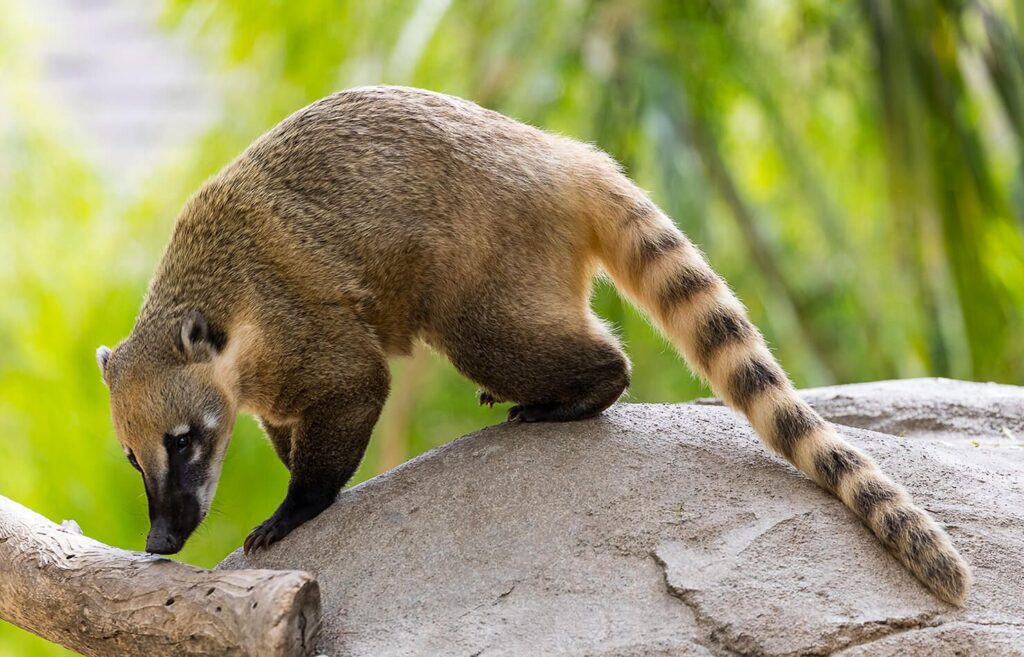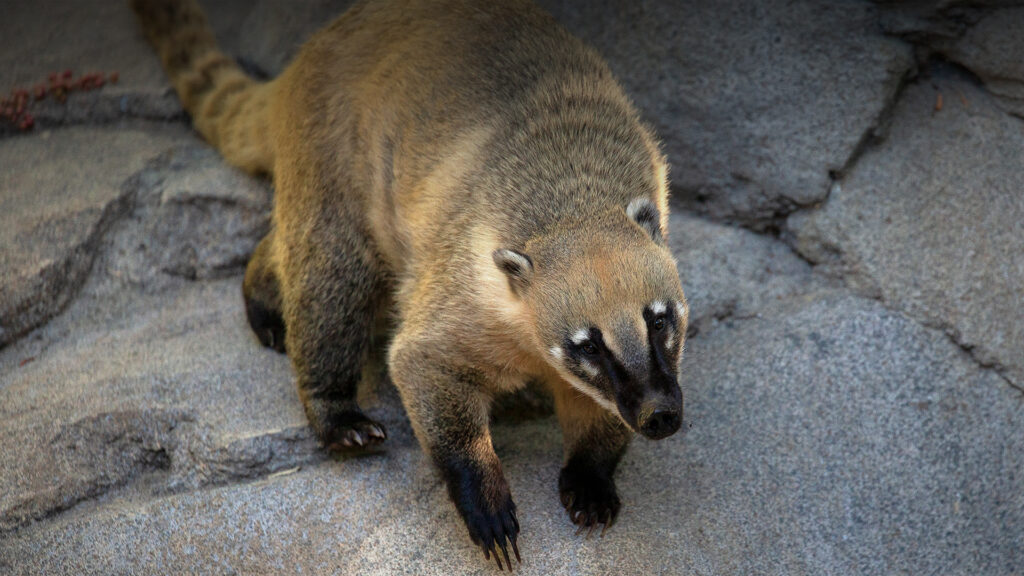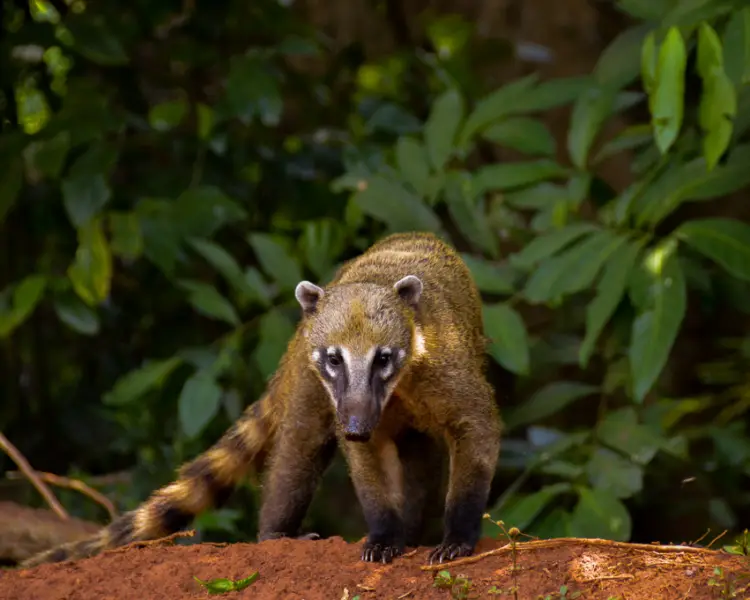Table of Contents
ToggleIntroduction

The Coatimundi, or coati, is a raccoon family (Procyonidae) member widely distributed across North, Central, and South America. The term “Coatimundi” is derived from the Tupian languages of South America, where “kuai” means belt and “munde” means an animal, hinting at the long, slender body of the creature. This omnivorous mammal is notable for its elongated snout, masked face, and bushy, ringed tail that often stands erect, creating a distinctive silhouette.
Four recognized coatis species include the white-nosed coati (Nasua narica), the South American coati (Nasua nasua), the mountain coati, and the eastern mountain coati. Each species’s distribution, habitat preference, behavior, and physical characteristics differ.
The Origin And Taxonomy Of Coatimundis
Coatimundis are believed to have evolved in South America, diversifying into several species before spreading into Central and North America. The earliest known ancestors of coatis, from the family Procyonidae, are believed to have emerged around 30 million years ago. The Coatimundi, along with other family members like raccoons and olingos, has its roots in this evolutionary history.
Taxonomically, coatis belong to Carnivora, which includes both carnivorous and omnivorous mammals. Despite their classification in Carnivora order, coatis are omnivores with a diet that includes fruits, invertebrates, and other small animals. Their family, Procyonidae, has other similarly-sized omnivores like raccoons and kinkajous.
The genus Nasua, which includes the white-nosed and South American coatis, is distinguished by the coatis’ social behavior and more terrestrial lifestyle. On the other hand, the genus Nasuella, which includes the mountain coatis, is characterized by a more arboreal or tree-dwelling lifestyle.
Despite their widespread distribution and distinctive behaviors, the coatis’ biological study is still developing. As such, our understanding of these unique and fascinating creatures continues to evolve. They remain a testament to the remarkable diversity of life in the Americas, and their intriguing social structures, adaptability, and behaviors make them a captivating subject of study.
Physical Characteristics
Description of Appearance
Coatimundis are distinctively recognizable due to their characteristic physical features. Their bodies are slender and elongated, covered in a coat of fur ranging from light brown to black, depending on the species and individual. The skin is typically thicker and shaggier on its undersides and tails. Their faces bear a lighter shade, often adorned with a mask-like dark marking around the eyes.
One of the coati’s most striking features is its flexible, elongated snout, accounting for about one-third of the head-body length. The bill ends with a mobile, disk-like nose, which they use for rooting in the soil for food. Its sense of smell is highly developed, aiding it in locating food items hidden under leaves or ground.
The coati’s tail is another signature feature, nearly as long as the head and body combined. The tail is ringed with alternating light and dark bands and often held erect, especially when the animal is on the ground, serving as a balance aid while climbing and as a signal to other coatis during group activities.
The coati’s feet are adapted for both terrestrial and arboreal life. They possess sharp, curved claws, which are excellent for digging in the soil and provide a firm grip while climbing trees.
Size And Weight
Coatimundis are medium-sized mammals. An adult coati typically measures between 85 and 113 cm (33 and 44 inches) from head to tail, with the bottom accounting for around half of that length. Males are significantly larger than females, a characteristic known as sexual dimorphism. Male coatis can weigh up to 12 kg (26 pounds), while females usually weigh between 2.5 and 4.5 kg (5.5-10 pounds).
The size of a coati can vary based on its geographical location, diet, and species. For instance, the South American coati tends to be larger than its North American counterpart.
Lifespan
Coatis in the wild usually live to be 7-8 years old, though some individuals have been known to live up to 10 years. In captivity, however, with consistent access to food, veterinary care, and protection from predators, they can live up to 15-16 years. Several factors affect a coati’s lifespan, including predation, disease, habitat loss, and accidents. Mortality is often higher among young coatis and males, the latter due to their solitary lifestyle and increased exposure to threats.
These aspects of the coati’s physical characteristics play crucial roles in interacting with their environment, locating food, escaping predators, and living their day-to-day lives. They highlight the adaptation and resilience of this species to its natural surroundings.
Habitat and Distribution

Description of Typical Habitats
Coatimundis are highly adaptable mammals, capable of thriving in various environments. They are most commonly found in forests, from the dense rainforests of the Amazon to the deciduous forests of Central America and the southwestern United States.
Coatis have also adapted to more arid environments, like desert-edge habitats. They can range from sea level up to 3,000 meters in the Andes. Their adaptability allows them to inhabit a variety of forest structures, including both primary and secondary forests, as well as disturbed habitats.
Within these habitats, coatis are terrestrial and arboreal, meaning they spend time on the ground and in trees. Their strong legs and sharp claws make them excellent climbers, and they often retreat to the safety of tree branches to sleep or escape from predators. However, they are also comfortable on the ground, where they forage for most of their food.
Geographic Distribution
Coatimundis can be found all across the Americas. Except for the icy southern tip and the dry western coastline, the South American coati (Nasua nasua) can be found in every other part of South America. On the other hand, the white-nosed coati is native only to Central America and has a white nose. The southwest United States (Arizona, New Mexico, and Texas), Mexico, and even some of Colombia are all within its range.
The mountain coatis are more restricted in their distribution, mainly in the high-altitude regions of the Andes in Colombia, Ecuador, and potentially northern Peru.
Adaptations to Various Environments
Coatis possess several adaptations that allow them to survive in their diverse environments. Their long, flexible snouts will enable them to probe into crevices and under rocks to find food, and their sharp claws are perfect for digging and climbing trees. Coatis are also excellent swimmers, which can come in handy in the river-filled landscapes of their habitats.
They have a keen sense of smell, about 13 times stronger than humans. This is critical for locating food, especially given their omnivorous diet. Their ability to conceal themselves in the background, thanks to their color, is another defense against predators.
Coatis have adapted to different weather conditions as they live across various climates. In the cooler mountainous regions, they have denser fur. In hot, arid environments, coatis have learned to find water-rich food sources and have become adept at finding shade and conserving energy.
Their adaptability and resilience have enabled coatis to inhabit diverse American environments. This also suggests their potential to withstand specific environmental changes, making them an intriguing subject for animal behavior and adaptation studies.
Relationship With Humans

Historical Interactions and Significance
Historically, coatis have had varied interactions with humans, influenced heavily by the cultural significance attributed to them. In many native cultures of Central and South America, coatis were seen as symbols of cunning and resourcefulness. Some societies even integrated the coati into their mythologies and storytelling.
In several indigenous communities, coatis were hunted for meat and hide, while others revered them as sacred animals, forbidding their hunting. In some South American cultures, coati teeth have been used to make necklaces and other personal adornments.
The Coatimundi in Popular Culture
In more contemporary times, the coati has emerged in popular culture. They are often featured in nature documentaries due to their fascinating social behaviors and distinct appearance. In addition, coatis have found a place in children’s literature and animated films, often personified and portrayed as clever and resourceful characters.
Some zoos and wildlife parks worldwide house coats, attracting visitors with playful behavior and agility. Their naturally curious and friendly nature can make them appealing as pets. Still, they are not ideal domestic animals due to their tendency towards aggressive behavior when mature and their complex dietary and environmental needs.
The Effects of Habitat Destruction and Human Interaction
More somberly, human activities have begun to pose significant threats to coatis. Deforestation, urbanization, and agriculture have lost large swaths of coati habitat. Moreover, coatis are often victims of road accidents as expanding road networks intersect their habitats.
While not typically targeted by hunters for their meat or fur, they can be indirectly affected by human hunting activities that disrupt their ecosystems and food sources. Climate change, driven by human activity, also threatens to disrupt the delicate balance of the ecosystems in which coatis live.
Conclusion
Coatimundis, or coatis, are fascinating and resourceful creatures inhabiting various American environments. Their unique behavioral traits, diet, and social structures provide invaluable insights into their adaptability and survival strategies.
From a broader ecological perspective, Coatimundi plays a significant role in the ecosystems they inhabit. As omnivores, they help to control pest populations, and their fruit-eating habits contribute to seed dispersal, thereby maintaining plant biodiversity. Their interesting social structures, primarily consisting of female-dominated groups, add a unique dimension to our understanding of animal behavior.
However, despite their adaptability and resilience, coatis face increasing threats due to human activity. Deforestation, urbanization, hunting, road accidents, and the exotic pet trade pose significant challenges to their survival. These issues underscore the need for comprehensive conservation efforts to preserve these animals and their natural habitats.







